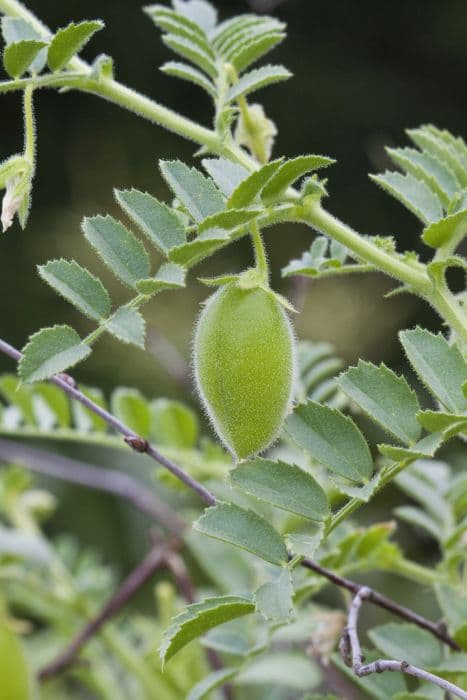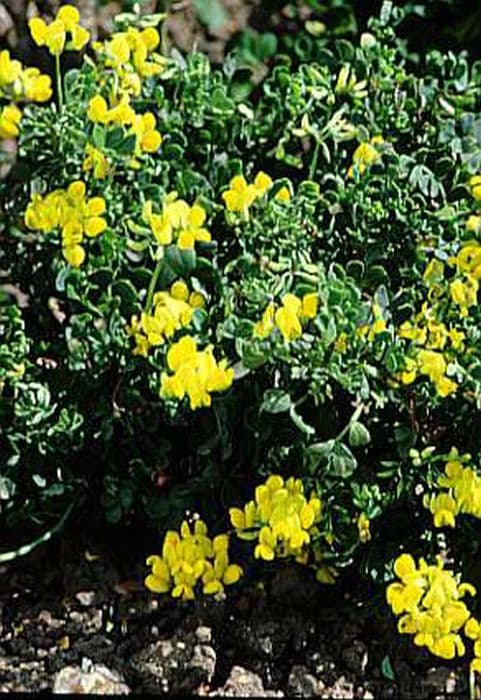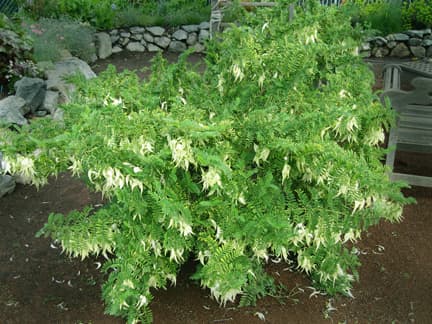Tangier Pea Lathyrus tingitanus

ABOUT
Lathyrus tingitanus, commonly known as Tangier pea, is a flowering plant characterized by its climbing habit and showy flowers. The plant typically bears pinnate leaves, which consist of multiple leaflets arrayed on either side of a central stem, ending in tendrils that wrap around supporting structures for anchorage and climbing. The flowers of the Tangier pea are quite distinctive and are one of its most striking features. They usually bloom in clusters and display a range of colors, often in shades of pink, red, or purple, with some variations exhibiting a bicolor pattern. The flowers have a characteristic butterfly-shaped structure known as the pea flower shape, typical of the legume family to which it belongs. The seed pods which follow the flowering phase are also an identifying aspect of the Tangier pea. These pods encase the seeds and may exhibit a slender, elongated shape, sometimes slightly curved, and they open along a seam when the seeds are mature. The overall appearance of the Tangier pea is that of a sprawling or climbing plant with leafy vegetation, bright, attractive flowers, and elongated seed pods, making it a notable presence in gardens or wild settings where it occurs naturally.
About this plant
 Names
NamesFamily
Fabaceae
Synonyms
Tangier Pea, Tangiers Pea
Common names
Lathyrus roseus, Lathyrus tingitanus var. roseus, Orobus roseus.
 Toxicity
ToxicityTo humans
The Tangier pea is potentially toxic when ingested by humans, particularly the seeds. It contains a neurotoxic amino acid called ODAP (β-N-oxalyl-L-α,β-diaminopropionic acid) or BOAA, which can cause a neurological disorder known as lathyrism if consumed in large quantities over time. Lathyrism is characterized by symptoms such as muscle weakness, paralysis of the lower limbs, and even breathing difficulties. Chronic consumption can lead to permanent paralysis and neurodegenerative changes.
To pets
The Tangier pea can be toxic to pets such as cats and dogs if ingested. The presence of amino acids like ODAP can cause lathyrism in animals, leading to similar symptoms as in humans, such as difficulty walking, muscle weakness, and potentially paralysis. It is important to prevent pets from ingesting this plant, particularly the seeds, to avoid these toxic effects.
 Characteristics
CharacteristicsLife cycle
Annuals
Foliage type
Deciduous
Color of leaves
Green
Flower color
Magenta
Height
6 feet (1.8 meters)
Spread
1 foot (0.3 meters)
Plant type
Climber
Hardiness zones
7
Native area
Mediterranean
Benefits
 General Benefits
General Benefits- Nitrogen Fixation: Lathyrus tingitanus, also known as Tangier pea, has the ability to fix atmospheric nitrogen, which can help enrich the soil and reduce the need for chemical fertilizers.
- Erosion Control: The root system of Tangier pea helps stabilize the soil, making it a good choice for combating erosion in vulnerable areas.
- Biodiversity: It serves as a host for various insect species, contributing to the diversity of local ecosystems.
- Ornamental Uses: With its colorful flowers, the Tangier pea is often grown for ornamental purposes in gardens and landscapes.
- Wildlife Habitat: It provides shelter and food for wildlife, including birds and beneficial insects.
- Cover Crop: Tangier pea can be used as a cover crop to suppress weeds, prevent soil compaction, and improve soil structure.
- Food Source for Livestock: It can be used as fodder for livestock, offering a supplementary feed source.
- Green Manure: When plowed under, it acts as green manure, improving soil fertility and organic matter content.
 Medical Properties
Medical PropertiesThis plant is not used for medical purposes.
 Air-purifying Qualities
Air-purifying QualitiesThis plant is not specifically known for air purifying qualities.
 Other Uses
Other Uses- Lathyrus tingitanus, commonly known as Tangier pea, can be used in floral arrangements, providing a delicate and vibrant touch to bouquets.
- As a nitrogen-fixing plant, it can improve soil quality when included in crop rotation or planted as a cover crop.
- The tendrils and supports of Tangier pea can create living fences or privacy screens when grown along trellises in gardens.
- The plant can serve as a natural dye, with its flowers potentially providing pigments for coloring fabrics or crafts.
- As a fast-growing plant, Tangier pea can be used for erosion control, helping to stabilize soil on slopes and prevent landslides.
- Garden enthusiasts might use Tangier pea as an educational tool to teach about plant growth, climbing mechanisms, and legume family characteristics.
- For photographers and artists, the plant can be a captivating subject that showcases intricate flower structures and climbing habits.
- In areas where it is non-invasive, the plant can contribute to biodiversity by providing habitat and food for pollinators like bees.
- The dried seeds and pods of Tangier pea may be used in crafting activities, such as creating natural jewelry or ornaments.
- Culinary experimentation with Tangier pea involves using its young shoots and leaves, but only where the plant is known to be safe and non-toxic, as some species of Lathyrus carry toxins.
Interesting Facts
 Feng Shui
Feng ShuiThe Tangier pea is not used in Feng Shui practice.
 Zodiac Sign Compitability
Zodiac Sign CompitabilityThe Tangier pea is not used in astrology practice.
 Plant Symbolism
Plant Symbolism- Connection: The climbing nature of Tangier pea (Lathyrus tingitanus) symbolizes the ability to form connections and support structures, as it often uses tendrils to connect to and climb up structures or other plants.
- Affection: Like many members of the pea family, the delicate flowers of Tangier pea may symbolize affection and tender feelings one person may hold towards another.
- Independence: The ability of Tangier pea to grow robustly and cover large areas quickly can symbolize independence and self-sufficiency, as it thrives without much need for human intervention.
- Prosperity: Tangier pea’s vigorous growth habit may also symbolize prosperity and abundance, as it produces many seeds and can spread easily, metaphorically representing the proliferation of resources or wealth.
 Water
WaterThe Tangier pea plant should be watered deeply once the top inch of soil feels dry to the touch, typically once a week, but this may vary depending on the climate and the plant's environment. It is crucial to avoid overwatering, as this can lead to root rot. When watering, use approximately one to two gallons of water per plant, ensuring that the soil is thoroughly moistened. During hotter seasons or in particularly dry climates, the frequency of watering may need to increase to maintain an evenly moist soil without waterlogging.
 Light
LightTangier pea plants thrive in full sunlight conditions, requiring at least six hours of direct sun daily. The best spot for these plants is an area where they can receive unfiltered sunlight throughout the day. If you live in an exceptionally hot climate, some light afternoon shade may help protect the plant from excessive heat.
 Temperature
TemperatureTangier pea plants perform best in temperate conditions and can tolerate a temperature range of about 40 to 85 degrees Fahrenheit. The ideal temperature for robust growth and flowering usually falls within the range of 60 to 75 degrees Fahrenheit. While these plants can withstand light frosts, they should be protected from sustained temperatures below 40 degrees Fahrenheit.
 Pruning
PruningPruning Tangier pea plants encourages bushier growth and can prevent disease by improving air circulation. Prune in the late winter or early spring before new growth begins. Remove dead or diseased stems, as well as thinning out crowded areas. Pruning may be repeated after the flowering period to maintain the desired shape and to remove spent blooms and seed pods, which helps stimulate new flower production.
 Cleaning
CleaningAs needed
 Soil
SoilFor Tangier pea, prepare a well-draining soil mix consisting of equal parts potting soil, peat, and perlite or sand. A pH that ranges from slightly acidic to neutral (pH 6.0-7.0) is ideal for this plant.
 Repotting
RepottingTangier pea should be repotted every one to two years or when it outgrows its current container. It's important to ensure proper root space for healthy growth.
 Humidity & Misting
Humidity & MistingTangier pea prefers moderate humidity levels but is quite adaptable to different conditions, avoiding overly dry or humid environments.
 Suitable locations
Suitable locationsIndoor
Place Tangier pea near a sunny window and ensure moderate humidity.
Outdoor
Plant Tangier pea in a sunny spot with well-draining soil.
Hardiness zone
7-10 USDA
 Life cycle
Life cycleLathyrus tingitanus, commonly known as Tangier Pea, begins its life cycle with seed germination, typically in well-drained soil during spring after the danger of frost has passed. The seedlings emerge and grow rapidly, developing true leaves and a climbing or trailing vine structure. As the plant matures, it produces distinctive pink-purple flowers, often in a pea-like shape, which emerge through the warmer months. Following pollination, which can be facilitated by insects, the flowers develop into pods containing the seeds. These pods dry and eventually release the seeds back into the soil to complete the reproductive cycle. Throughout the growing season, the Tangier Pea requires adequate sunlight and moderate water to thrive before entering dormancy or dying after setting seed, depending on the climate and conditions.
 Propogation
PropogationPropogation time
Spring to early summer
Lathyrus tingitanus, commonly known as Tangier Pea, is typically propagated by seed. The most popular method of propagation for this plant involves sowing the seeds directly where the plant is intended to grow, after all risk of frost has passed and the soil has warmed up. Ideally, this time falls in the spring. Before sowing, it can be helpful to soak the seeds in water for 24 hours to soften the hard outer coating and promote germination. Once soaked, seeds are sown at a depth of about 1 inch (2.54 cm) and spaced a few inches apart. The seeds will usually germinate within 2 to 3 weeks, and then you can thin the seedlings to about 6 inches (15.24 cm) apart to allow enough space for the mature plants. Regular watering and support for climbing, if necessary, will help the Tangier Pea thrive.



![Kowhai [Sun King]](/_next/image?url=https%3A%2F%2Fplants-admin.emdemapps.com%2Fimages%2Fplants%2F%2Fimages%2F604b57cb7f598.png&w=640&q=75)





